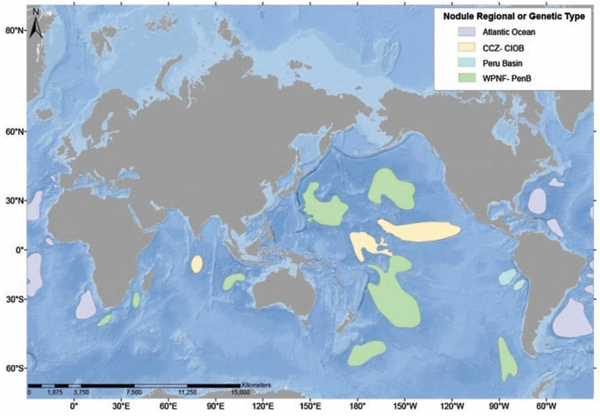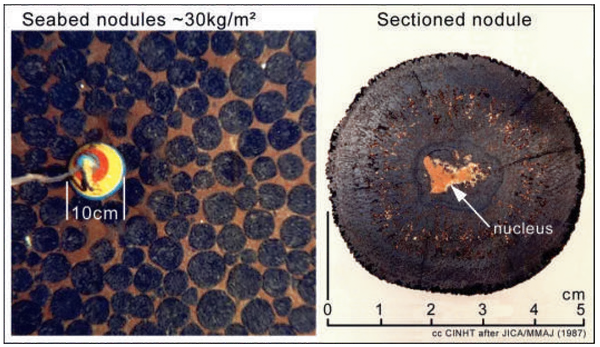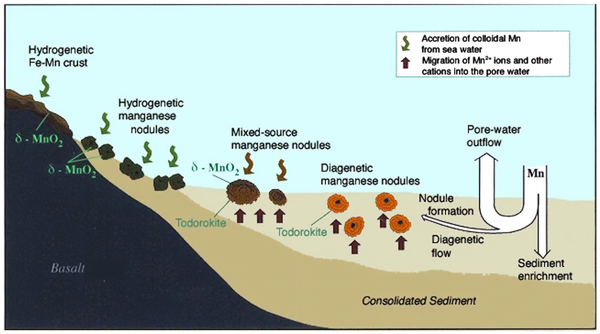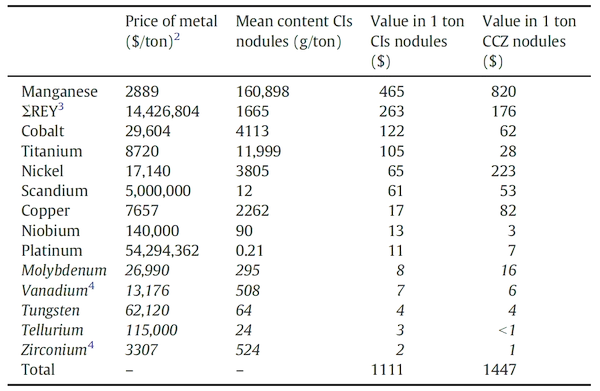Polymetallic Nodule Formation
Introduction
Polymetallic nodules are mineral concretions found on the abyssal plains of major ocean basins. They're typically spheroidal, around 5-15cm in diameter, and sit on the silty seabed. These nodules have generated considerable interest due to their rich content of valuable metals.
Origins and Composition
Polymetallic nopdules are found on the deep abyssal plains of the world's oceans, primarily in the North and South Pacific, the Indian Ocean, and the Atlantic Ocean. They are comprised of layers of iron and manganese hydroxides around a core, and can contain nickel, copper, cobalt, and rare earth elements.
 "Estimates of Metals Contained in Abyssal Manganese Nodules and Ferromanganese on Regional Variations and Genetic Types of Nodules", Hein et al
"Estimates of Metals Contained in Abyssal Manganese Nodules and Ferromanganese on Regional Variations and Genetic Types of Nodules", Hein et al
Formation Mechanisms
Polymetallic nodules form through the precipitation of metals (typically in oxide form) out of the seawater and onto a nucleus (typically a shark's tooth, rock or piece of debris) or an existing polymetallic nodule. This process is very slow, and nodules typically grow at a rate of a few mm per million years.
 "Cook Islands Seabed Minerals a precautionary approach to mining", 2016, Gerald McCormack
"Cook Islands Seabed Minerals a precautionary approach to mining", 2016, Gerald McCormack
The specific process is dependent upon various criteria, and may be driven either by precipitation from the seawater itself (hydrogenetic process), from the pore water in the sediments below the nodule (diagenetic process), or a combination of the two:
1. Hydrogenetic Process
- Dominant process where metals are oxidized from seawater onto nodules.
- Involves reactions in which dissolved metals in seawater precipitate on the nodule surfaces.
2. Diagenetic Process
- Metals are sourced from pore water present in underlying sediment layers.
- As this metal-rich pore water moves upward, metals precipitate upon encountering the nodule.
 "Deep-ocean mineral deposits as a source of critical metals for high- and green-technology applications: Comparison with land-based resources", 2013, Hein et al
"Deep-ocean mineral deposits as a source of critical metals for high- and green-technology applications: Comparison with land-based resources", 2013, Hein et al
Growth Rate and Characteristics
- Extremely slow growth, often a few millimeters over a million years.
- Larger nodules might be tens of millions of years old.
- Found predominantly in regions with low sediment accumulation to prevent burial.
Mining Opportunities
There are estimated to be around 210 trillion dry tons of polymetallic nodules worldwide.
Based upon typical compositions, the contained minerals in a nodule from the Clarion-Clipperton Zone are estimated to be worth around $1447 per dry ton, whereas the the contained minerals in a nodule from the Penrhyn Basin are estimated to be worth around $1111 per dry ton:
 "Critical metals in manganese nodules from the Cook Islands EEZ, abundances and distributions", 2015, Hein et al
"Critical metals in manganese nodules from the Cook Islands EEZ, abundances and distributions", 2015, Hein et al
This leads to an estimated total value of around $233 trillion of polymetallic nodules worldwide. The actual producible amount of nodules and metal would be far less than this, due to set aside areas, Biodiversity Protection Zones, production factors, and inefficiencies.
Conclusion
Polymetallic Nodules present a vast and untapped opportunity for producing large amounts of critical metals.
These nodules have formed slowly over millions of years due to the precipitation of metal oxides from the seawater, via a variety of different mechanisms. The nodules composed of very large amount of critical metals, and they far exceed the quality of currently exploitable terrestrial ores.
Extremely large volumes of polymetallic nodules are present in the world's oceans, and the economic value is extremely high.